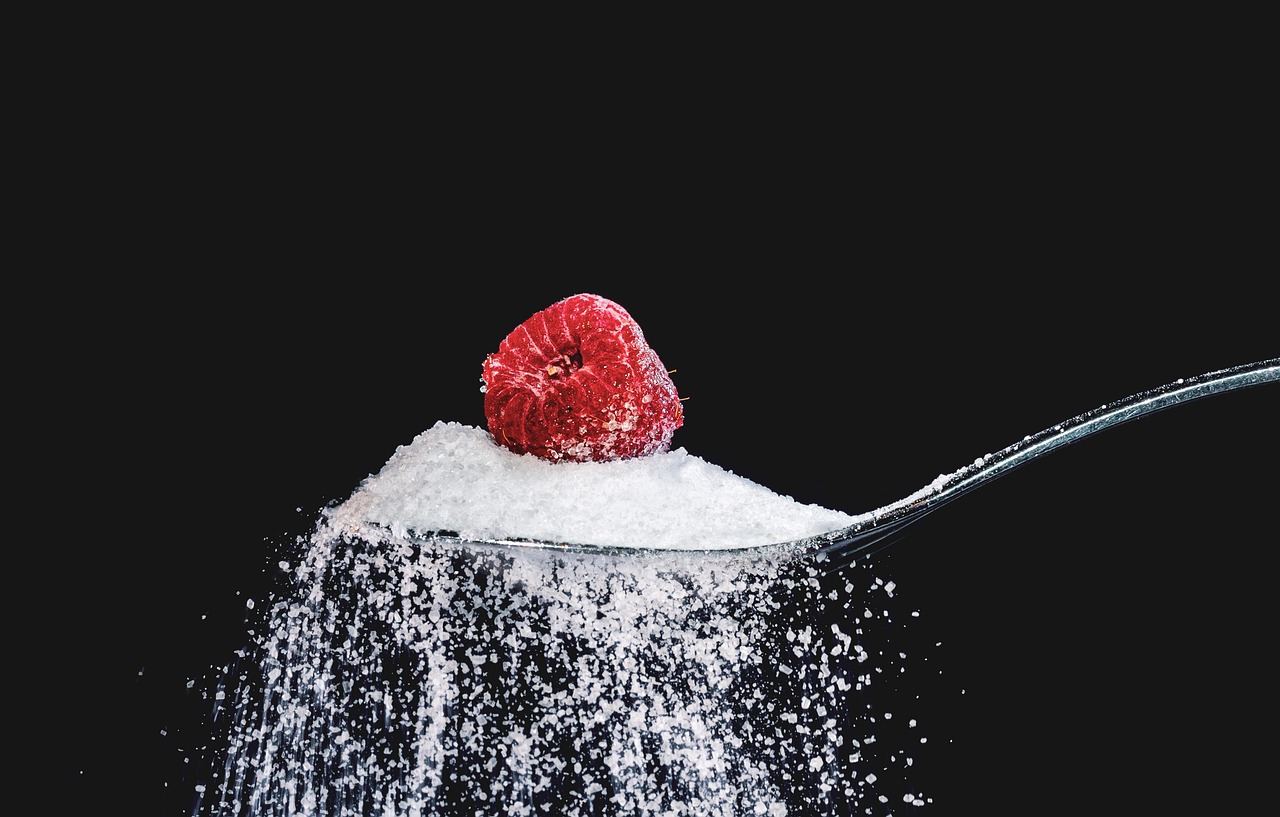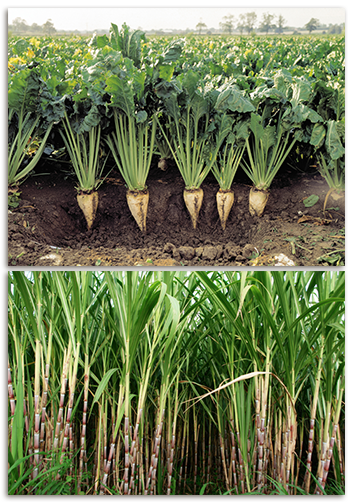Background Agricultural Connections
Sugar is a type of carbohydrate. Carbohydrates are macronutrients that our bodies need. They can be classified as either simple or complex. Complex carbohydrates are starches like bread and rice. Sugar, however, is a simple carbohydrate (made of one or two sugars). There are many types of sugar. For example, there are three types of sugar that can be found in fruit juice. They are fructose, glucose, and sucrose. They are nutritionally similar, providing 4 calories/gram. Fructose can be found in honey and fruit. Glucose is the primary simple sugar our bodies use for energy. Sucrose is table sugar (white sugar) and is created by linking fructose and glucose. Once in our bodies, these sugars work to supply us with energy. Grape juice has a 1:1 ratio of fructose to glucose and contains less fructose than other juices. Apple juice has a 2:1 ratio of fructose to glucose, making this juice lower in glucose. Juice that contains sucrose on the ingredient list contains added sugar along with the natural sugars present in fruit. Natural sugars are those already present in food. In order for our bodies to use carbohydrates for energy, they must be broken down into glucose. Glucose is the primary source of fuel for our body. Insulin is a hormone produced by the pancreas that transports glucose from the blood to our cells. If our bodies do not produce enough insulin, there will be too much glucose in our blood, leading to serious health problems such as diabetes. Diabetes is a disease in which the body is unable to produce insulin. Type I diabetes occurs when a person does not produce insulin at all, while Type II diabetes occurs when someone develops insulin resistance. Insulin resistance results in a diminished ability to respond to insulin causing the pancreas to produce more insulin. This will eventually overwork the pancreas and prevent it from producing enough insulin.
In order for our bodies to use carbohydrates for energy, they must be broken down into glucose. Glucose is the primary source of fuel for our body. Insulin is a hormone produced by the pancreas that transports glucose from the blood to our cells. If our bodies do not produce enough insulin, there will be too much glucose in our blood, leading to serious health problems such as diabetes. Diabetes is a disease in which the body is unable to produce insulin. Type I diabetes occurs when a person does not produce insulin at all, while Type II diabetes occurs when someone develops insulin resistance. Insulin resistance results in a diminished ability to respond to insulin causing the pancreas to produce more insulin. This will eventually overwork the pancreas and prevent it from producing enough insulin.
The solubility of a substance is defined as the amount of solute that will dissolve in a solvent. A solute is the substance that dissolves in a liquid. A solvent is the liquid that dissolves the solute. For example, in a sugar water solution, the sugar (solute – substance present in least amount) will dissolve in water (solvent – substance present in larger amount). Sugar solubility in water increases when temperature increases. The heated water molecules move faster, allowing the sugar to more readily fit between the water molecules. For example, if you add table sugar to tea that has already cooled, the sugar will collect at the bottom of the glass. This happens because the molecules in the cold tea are not moving as quickly as the hot tea, preventing the sugar from readily dissolving. The result is a tea that will taste less sweet until you reach the bottom, where all the sugar has collected. Since heat makes sugar more soluble, we should be aware of foods containing sugar that have been heated during preparation (e.g. some sweetened beverages and candy). It is important to be aware of the types of sugar in these products. For example, naturally sweetened orange juice will be a better choice when compared to another with added sugar. Naturally sweetened products contain only the sugar found in the product and do not have added sugar.
FoodMASTER Middle Lessons
FoodMASTER (Food, Math and Science Teaching Enhancement Resource) is a compilation of programs aimed at using food as a tool to teach mathematics and science. For more information see the Background & Introduction to FoodMASTER for Middle School. This lesson is one in a series of lessons designed for middle school:

 In order for our bodies to use carbohydrates for energy, they must be broken down into glucose. Glucose is the primary source of fuel for our body. Insulin is a hormone produced by the pancreas that transports glucose from the blood to our cells. If our bodies do not produce enough insulin, there will be too much glucose in our blood, leading to serious health problems such as diabetes. Diabetes is a disease in which the body is unable to produce insulin. Type I diabetes occurs when a person does not produce insulin at all, while Type II diabetes occurs when someone develops insulin resistance. Insulin resistance results in a diminished ability to respond to insulin causing the pancreas to produce more insulin. This will eventually overwork the pancreas and prevent it from producing enough insulin.
In order for our bodies to use carbohydrates for energy, they must be broken down into glucose. Glucose is the primary source of fuel for our body. Insulin is a hormone produced by the pancreas that transports glucose from the blood to our cells. If our bodies do not produce enough insulin, there will be too much glucose in our blood, leading to serious health problems such as diabetes. Diabetes is a disease in which the body is unable to produce insulin. Type I diabetes occurs when a person does not produce insulin at all, while Type II diabetes occurs when someone develops insulin resistance. Insulin resistance results in a diminished ability to respond to insulin causing the pancreas to produce more insulin. This will eventually overwork the pancreas and prevent it from producing enough insulin.
